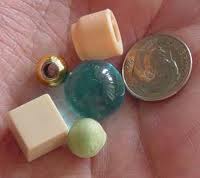Taking Care of a Premature Baby
 Premature babies are defined as those born between twenty four and thirty seven weeks of gestation. An average Indian baby weighs about 2.8 kgs when born at full term. According to the World Health Organization, any baby who weighs less than 2.5 kgs is termed as a “low birth weight” baby, irrespective of when the baby is born during a pregnancy. In general babies, who weigh less than 2 kgs, need specialized neonatal care for the initial few weeks after birth, until they are much stronger and ready to go home.
Premature babies are defined as those born between twenty four and thirty seven weeks of gestation. An average Indian baby weighs about 2.8 kgs when born at full term. According to the World Health Organization, any baby who weighs less than 2.5 kgs is termed as a “low birth weight” baby, irrespective of when the baby is born during a pregnancy. In general babies, who weigh less than 2 kgs, need specialized neonatal care for the initial few weeks after birth, until they are much stronger and ready to go home.
The chances of survival for a baby born before twenty four weeks of pregnancy are narrow. Premature babies are very delicate and needs to be handled with lots of care and alertness. It is observed that generally the premature babies are vulnerable to external climatic changes too and due to low resistance are prone to illnesses quickly. That is the reason premature babies are kept away from visitors. These extra precautions will improve the existing health condition of the baby.
Premature babies are transferred to intensive care unit immediately after birth. They are placed in incubators as they require round the clock nursing support. The premature babies are tiny, fragile and very difficult to handle in the initial days. Only nursing staff and experienced people should administer the baby. The premature babies are fed intravenously and at times put on respirator to aid breathing in certain situations.
Close monitoring is required for key parameters such as blood pressure, heart rate, breathing and pulse. Premature babies are retained in the incubator till the time the consulting doctor confirms that the babies health is stable and can be taken home. Even after premature baby is discharged from the hospital, periodical checks has to be conducted to ensure the baby is progressing well and you do not come across surprises in ignorance.
Bringing a premature baby home after several weeks in the hospital is very exciting yet stressful as you need to keep monitoring round the clock. Relatives, close friends and neighbors will be anxious to see the baby. Control should be maintained over the visitors as baby is prone to viral infections with exposure. Prevent insect bite, provide mosquito net.
Premature babies develop for two to four months outside the womb. During this period , they are exposed to different types of stimuli such as light, noises, touch and pain. They are comfortable when wrapped in blanket and the room is kept warm. A quieter environment with dim lights is recommended such that the baby stays calm. Parents and caretakers need to take extra care to nurture the baby. Start breast feeding based on availability.If you are opting for formula milk then follow all precautions while preparing feed.
Crying in premature babies:
Crying is a common phenomena in babies and a way of communication with those around them. Some infants cry more than the other babies. Crying may indicate several reasons- baby is hungry, seek attention , need a diaper change, some sort of an irritation or displeasure with the environment.
Premature babies are more fussy and cry often. Babies continue to cry in spite of all basic needs addressed. If babies are kept in the Intensive neonatal unit they will take time to adjust to the new environment. Usually baby is separated from the new mom who is recovering after the delivery and probably in another ward of the hospital to support feeds for the baby.
Unusual crying in premature babies:
By the time the baby is 3 to 4 weeks, the parents and elders taking care of the baby will be able to identify the cause of the cry. In case you sense that the baby is crying for more than the usual time is not stopping to cry with all the efforts to soothe the baby you need to consult a pediatrician and take medical advice. Unusual behavior and crying pattern should be mentioned to the doctor which will aid in diagnosis.
Prior to taking medical advice rule out the possibility of the baby being hungry, Baby diaper is clean and dry, no signs or symptoms of pain in the ear, check for body temperature, redness on the body due to insect bite. Pacify and soothe the premature baby from crying by holding the baby close to the body and talking to the baby in soft tones. If the baby has a liking to music, distract the baby with light music or shift the babies attention with baby toys and favorite posters. Sing songs that the baby enjoys usually and try to put the baby to sleep. Baby may cry if it feels cold too. Wrap the baby with clothes that provide warmth if the external weather is cold, baby will feel comfortable in warm clothes.
Read: How to handle the New Born Baby
Monitoring baby’s progress
Round the clock monitoring has to happen. Therefore if you are hiring baby sitter for caring the baby, ensure the help is an experienced one. Create awareness and be alert. The mother will be also on medication post delivery. Share responsibilities and create a happy environment for the baby.
Closely watch out during seasonal transition and be able to interpret the symptoms. Premature babies are more fussy when compared to the full term babies born at the normal stage of pregnancy. The initial weeks are very challenging and gradually your baby will outgrow this phase in no time.
You can add your comment based on your observations thru comments.
Read:Valuable tips on how to develop your baby’s brain
Choking prevention and First Aid for Babies
January 10, 2014 by admin
Filed under Baby Problems
 Choking is a major risk for infants and toddlers. Choking is a foreign object that is stuck at the back of the throat or cause muscular pains. High risk of choking is observed in little babies and toddlers who have started to crawl around. Young children below 5 years are also prone to choking. During movement from one place to another they will come across objects which they try to put into the mouth.
Choking is a major risk for infants and toddlers. Choking is a foreign object that is stuck at the back of the throat or cause muscular pains. High risk of choking is observed in little babies and toddlers who have started to crawl around. Young children below 5 years are also prone to choking. During movement from one place to another they will come across objects which they try to put into the mouth.
Choking risks for babies and toddlers:
Any object smaller than a D size battery is a choking risk for babies and toddlers. Keep away tiny objects away from the baby. Even baby toys that are detachable can be a cause of concern. Baby gets attracted to bright colors and will stuff into the mouth. The other concern is health as these objects are not clean and can cause stomach upset and watery motions.
Precautions to avoid choking:
Let us understand the various ways to prevent choking in babies and toddlers.
- Feed the baby in sitting position: The correct posture to feed a baby who has weaned is in the sitting position. If the baby runs around and plays while eating there is a high risk of choking. Keep the baby engaged by conversing or singing some songs / rhymes this will ensure he does not shift focus. He will be less tempted to move around. This way choking risk is eliminated.
- Feed small portion: Till the time the child develops a chewing habit, feed in small quantities i.e the size of a small chick pea. Do not feed large pieces like salad, carrot pieces etc. High chances of choking. The babies airways are small and any large particle will get blocked and cause choking.
- Clear baby’s area of small objects: Babies are very curious about the objects in the surrounding. They are captivated by the colors and shapes. They will put any object into the mouth. Check the area and clear small objects eg: coins,beads,fruits, nuts etc.

- Avoid detachable toys: Check toys during purchase. If you have received gifts for the baby check the toys for any sharp surfaces, loose parts. Check toys ongoing basis to ensure no safety risks / choking risks. Small loose parts can be placed into mouth. Keep a close supervision of the baby.
- Separate toys of the older children: Every child is engaged by the toys associated with their age. If there are siblings you need to watch out for the toys they play with. It is a common observation that little babies always love the items that are in the hands of the other kid i.e a toy or a pencil etc. If the sibling is a school going one keep stationary items out of the reach eg: rubber, sharpener, crayon pencils etc.
Read: How to make home safe for kids
Symptoms of choking in babies:
If your baby is suddenly unable to breathe, cry, cough or make noise i.e baby is still, not moving . This is a sign that the baby’s airways are blocked indicating choking.
You need to act fast and restore baby’s breathing. The baby will try to cough, it is a natural tendency but will be unable to do it. Your aim is to remove the obstruction and take the baby to the Doctor for further diagnosis.
How to act fast- First Aid for choking in infants
If the infant is worried and distressed, unable to cry, cough, or breathe:
- Lay them face down along your forearm, with their head low, and support the back and head
- Give up to five back blows, with the heel of your hand
- Check the infant’s mouth; remove any obvious obstructions
- Do not do a finger sweep of the mouth.
If the obstruction has not cleared, follow these steps:
- Turn the infant onto his back and give up to five chest thrusts
- Use two fingers, push inwards and upwards (towards the head) against the infants breastbone, one finger’s breadth below the nipple line
The aim is to relieve the obstruction with each chest thrust rather than necessarily doing all five
- Check the mouth.
- If the obstruction does not clear after three cycles of back blows and chest thrusts conduct CPR( Cardio Pulmonary Resuscitation) . This is basically providing breathe to the baby.
When the baby breath is restored, clean the baby and keep him comfortable as they will make a lot of noise mainly because of the pain and the sudden alarm the baby had gone through. Ensure you take the baby to the doctor the same day for checkup and inputs.
Do your best to prevent choking for your baby. Mothers with multi-tasking activities and the care takers or grand parents who are responsible for caring the baby in the absence of the mother need to be extra cautious.
You can include your inputs for Choking prevention and share your experiences in the comments.









